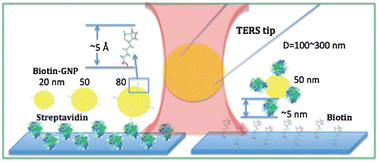
Streptavidin-biotin as example of receptor-ligand binding in TERS
Targeted nanoparticles and Tip-Enhanced Raman spectroscopy (TERS) can be used to investigate biomolecular interactions, suggests a new study published in Analyst.
Hao Wang and Zachary Schultz at the University of Notre Dame, USA, examine the effect of nanoparticle probe size on detected TERS signal obtained from different functionalised gold nanoparticles, and compare the observed TERS signals from aggregated nanoparticle SERS. TERS is usually employed in the analysis of carbon nanotubes, dye molecules, and semiconductors, but recently it has also been used for detection of molecules in biological samples.
According to the authors, the new methodology suggests a way to enhance TERS signals associated with protein receptors in biological systems that cannot be isolated on a metallic surface.
To read more about this research, please access the link below. This paper will be free to read until March 18th .
The chemical origin of enhanced signals from tip-enhanced Raman detection of functionalized nanoparticles
Hao Wang and Zachary D. Schultz
Analyst, 2013, Advance Article
DOI: 10.1039/C3AN36898J










